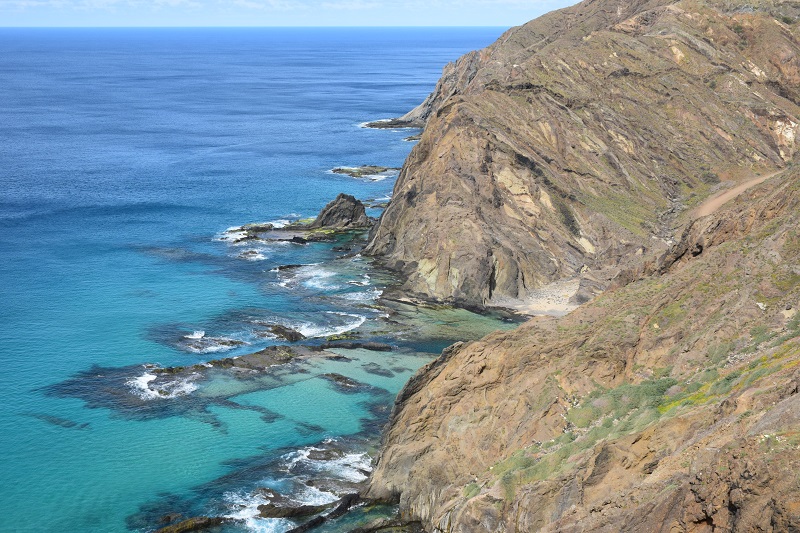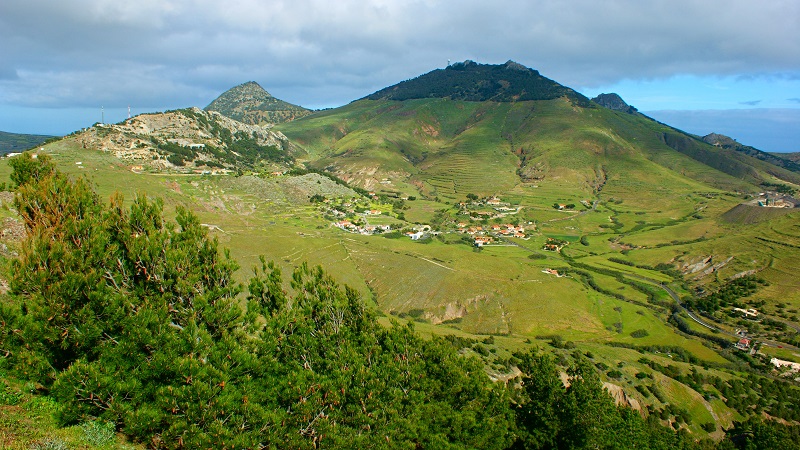DIVERSITY OF SPECIES
Terrestrial biodiversity is distributed over several ecosystems, from sea level to the zones of higher altitude, on the island and the islets, from the most natural environments to the humanised zones including agroforestry systems with typical crocheted walls, and paired stone walls, terraces or fields, irrigation canals as well as torrential correction work and reservoirs.
In this biological diversity, 396 endemic taxa (310 species, 84 subspecies and two varieties) can be identified, the equivalent of 24% of the total, representing a high level of endemic species. In endemisms, it is important to note the existence of 21 endemic genus, of which nine are exclusive to Porto Santo, namely Rhinothripiella in the arthropods and Callina, Hystricella, Idiomela, Lampadia, Lemniscia, Pseudocampylaea, Serratorotula and Wollastonaria in the gastropods, the remaining twelve endemism are common to Madeira and include Esuridea, Ellipsodes and Hadrus in the arthropods; seven genus in the gastropods (Boettgeria, Amphorella, Actinella, Caseolus, Discula, Spirorbula, Staurodon); Monizia and Chamaemeles in the vascular plants, some with infraspecific taxonomical categories exclusive to the proposed Reserve, like for example, Monizia edulis subsp. santosii.
In terrestrial biodiversity, animals dominate with 961 taxa, representing 58% of the total diversity and 319 endemisms. In the invertebrates (892 taxa), the arthropods are those with the greatest number of taxa (796) and endemisms (201), following the gastropods with 123 taxa and 103 endemisms. In contrast, the vertebrates show less specific diversity, including 69 taxa with 15 endemisms distributed into three classes: mammals (eight), reptiles (two) and birds (59).
In relation to the biodiversity of the marine environment, there are 453 taxa, with eight taxa endemic to Macaronesia, six species of fish, namely the canary damsel (Abudefduf luridus), the barred hogfish (Bodianus scrofa), the emerald wrasse (Centrolabrus trutta), the dotted moray (Muraena augusti), the scorpionfish (Scorpaena canariensis) and the island grouper (Mycteroperca fusca) and two bird taxa, the yellow-legged gull (Larus michahellis atlantis) and the shearwater [Puffinus lherminieri (P. assimilis)]. In the sea, worthy of mention are, the loggerhead sea turtle (Caretta caretta) and the Mediterranean monk seal (Monachus monachus) two species of the priority species of Annex II of the Habitats Directive, as well as the bottlenose dolphin (Tursiops truncatus), listed in Annex II of that directive and other cetacean species listed in Annex IV, like the short-beaked common dolphin (Delphinus delphis), the Atlantic spotted dolphin (Stenella frontalis) and the sperm whale (Physeter macrocephalus) among others.
DIVERSITY OF ECOSSYSTEMS
Characteristic land, coastal and marine ecosystems of the Macaronesian Biogeographic Region can be found on the Island of Porto Santo. The flora and fauna of the forests which were predominant in Europe during the Tertiary Period are noteworthy. In the coastal and marine environment, the presence of fossils which are witnesses to a reef period, which was also a precursor of dune formation, should be highlighted as well.
At the land-sea interface there are coastal dune systems which are dynamic, complex and mobile due to their location. They create a natural protection of the lands which are subjected to the erosive action of the waves and present an interesting halophytic and psammophytic vegetation.
In contrast to the extensive stretch of beach to the south, the northern slope is dominated by cliffs with small bays. These cliffs have accumulations of blocks of boulders and contain an endemic flora characteristic of the Macaronesian coasts, little or nothing unchanged by humans due to their inaccessibility. For that reason they were not the target of human activity in the past. On the northeast slopes, the last wild “zimbreiros” (juniper) (Juniperus turbinata subsp. canariensis) still survive today.
According to data from the last forest inventory of the RAM (IFRAM2, based on orthophoto maps of 2008), the predominant soil use in Porto Santo corresponds to the area covered by scrub and herbaceous plants. Herbaceous plants are the main component of forest areas, accounting for about 60% of the area, while forest and other wooded areas account for about 8%. Concerning the spatial distribution of forest areas, areas with forest and other wooded areas appear mainly in the extreme SW, covering areas of the Pico de Ana Ferreira and Morenos and in the zones of the mountainous system of the NE sector, including the Picos do Castelo, Facho, Gandaia, Juliana and the Pico Branco on the coast facing east.
The forest and other wooded areas appear mainly near the Pico de Ana Ferreira, Pico do Castelo and other hills in the northeast sector of the island. The peaks, some of them wild, correspond to rocky outcrops which are more resistant to erosion and include a forest cover comprised mostly of exotic perennial species. In the foothills, there is secondary vegetation dominated by the endemic fish-stunning spurge (Euphorbia piscatoria), which corresponds to remnants of Olea and Ceratonia forests. At higher altitudes, from the peaks of Facho and Gandaia and Pico Branco, there still survive remnants of laurel forests and a pioneer vegetation characteristic of siliceous rocks.
The Pico Branco and its surrounding area, which corresponds to ZEC PTPOR0002 (Special Area of Conservation), houses globally unique flora and fauna, typical Macaronesian habitats and landscapes of exceptional scenic value. Biodiversity highlights include plant and animal species under the Habitats and Birds Directives as well as priority habitats such as endemic Macaronesian heaths, Macaronesian Laurel forests and endemic forests of Juniperus spp. Its area of 135.5ha is extremely important within the scope of the safeguarding and valorisation of the natural heritage of the candidate Reserve.
In the streams and ravines scattered throughout the island are typical Mediterranean waterways with an intermittent character. Although the vegetation on these banks includes mainly introduced species, such as the French tamarisk (Tamarix gallica) and brambles (Rubus spp.), it also includes important native flora. Of the indigenous plants present, the Ruppia maritime vegetation, restricted to Ribeira da Serra de Dentro and Ribeira do Tanque should be mentioned. This aquatic plant is characteristic of the plant class Ruppietea maritimae, and in Madeira it has only been identified in the candidate reserve. Additionally, the dune ecosystem, fixed dunes with herbaceous plants, considered priority habitat in the Habitats Directive, harbours an endemic flora which should be preserved.
Agroforestry areas are particularly significant in the territory, covering about 74% of the land, mainly the central area of the Island of Porto Santo and some dispersed areas. The agricultural component covers about 6% of the island's territory in a landscape with human intervention, integrating small-scale production properties, cut by “crocheted” walls, which protect vineyards or vegetable gardens, the main daily productions of Porto Santo.
The candidate Reserve has a high diversity of ecosystems and houses various types or representations of land, coastal and marine habitats, some of which are listed in Annex I of the Habitats Directive and which should be mentioned because of their representation capability: 1110 Sandbanks which are slightly covered by seawater all the time, 1140 Mudflats and sandflats not covered by seawater at low tide, 1160 Large shallow inlets and bays, 1250 Vegetated sea cliffs with endemic flora of the Macaronesian coasts, 2130 Fixed coastal dunes with herbaceous vegetation (“grey dunes”) and 8220 Siliceous rocky slopes with chasmophytic vegetation.




